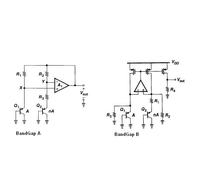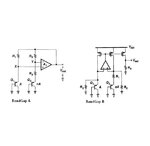gilbertomaldito
Full Member level 3
Hi
Attached are two simple types of bandgaps. I just want to ask what is the problem with bandgap A why books have to come up with bandgap B?
I know as I read the books that bandgap A has problems with the opamp's offset and resistors dependency on temperature, but I just dont understand how bandgap B solve bandgap A's problems?

Thanks
Andrew
Attached are two simple types of bandgaps. I just want to ask what is the problem with bandgap A why books have to come up with bandgap B?
I know as I read the books that bandgap A has problems with the opamp's offset and resistors dependency on temperature, but I just dont understand how bandgap B solve bandgap A's problems?

Thanks
Andrew
